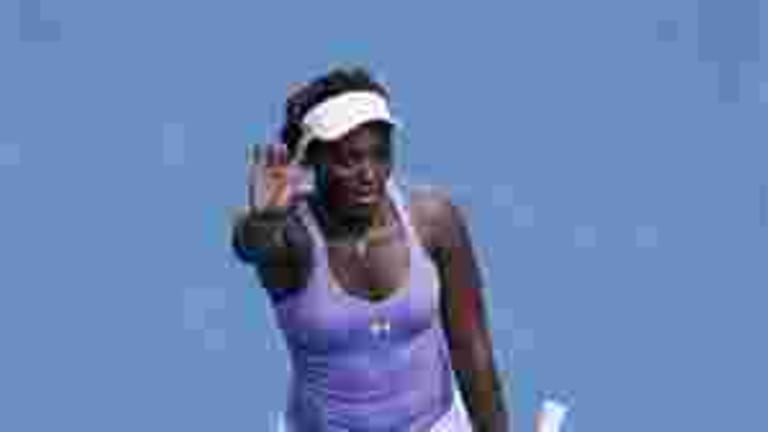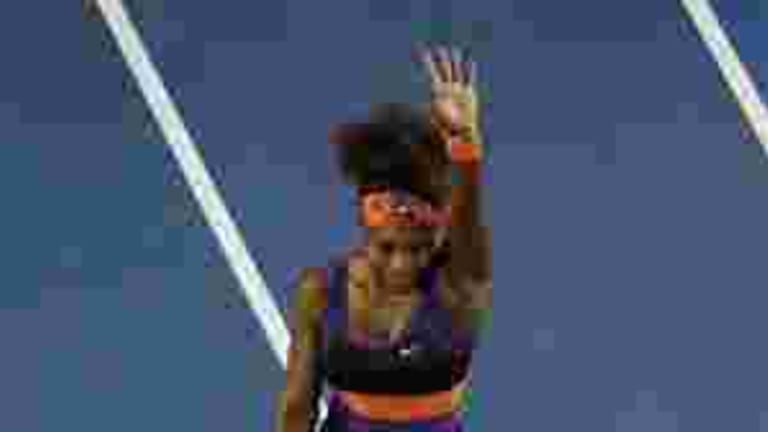MELBOURNE—Sloane Stephens is a Florida native and the daughter of a former NFL star from Louisiana, but it’s hard to imagine her hailing from anywhere other than Southern California. The 19-year-old—she’ll be 20 in March—practices in a town not too far south of Los Angeles, and, like any other teenage star in training, she says whatever she pleases and doesn’t seem to sweat much of anything. Those of us in the press love this. Compared to virtually every other hyper-focused and painstakingly managed tennis prodigy, Stephens is a breath of fresh chatter and a bona fide quote machine.
Consider the interview she did in Hisense Arena today, after beating Bojana Jovanovski 6-1, 3-6, 7-5 to reach her first Grand Slam quarterfinal. The chat lasted for approximately two minutes, but that’s all the time that the fast-talking Sloane needed to disarm and charm the crowd.
On her shaky second set: “Obviously you guys needed to see a show, so I gave you that today.”
On whether her mom was watching back in the States: “I’m sure she had like four heart attacks.”
On whether she buys herself anything special with her prize winnings: “I try to save all of my money, because I don’t want to be old and broke.”
On whether Serena Williams, who she plays in the quarters, has given her any advice: “Yesterday she told me that I don’t grunt and make enough noise, so hopefully she was watching today.”
That last line may or may not have been a sly reference to the hacking shreik with which Jovanovski punctuated the majority of her shots this afternoon. Later Sloane said that the noise hadn’t bothered her—“I didn’t even think about it, not even once.” But Jovanovski’s game did.
After being run off the court by Stephens and her rocket forehands in the first set, the 21-year-old Serb had taken the initiative and turned the tables in the second. Jovanovski moved up in the court and pushed Stephens back. Or, as Sloane said, “She brought it full force [in the] second, third set...She was going down the line on every shot. She’s hitting it with everything she has, and hitting it unbelievable. I mean, I couldn’t do anything.”
How did Stephens turn it back around in the third? She said she switched racquets for more power on her serve, and then, at 5-5, she found her rocket forehand again and broke Jovanovski. In truth, though, as so often happens against a hot opponent, Sloane really just kept plugging and hoping.
“Sometimes,” as she put it, “you just kind of got to stick it out, and hopefully she comes down off her throne.”
The standard worry about Sloane Stephens is that she’s too passive. She plays laid-back tennis, and doesn’t fully use all of her athletic gifts. (Sloane's mother was a swimmer, and her father was former New England Patriots running back John Stephens, who was killed in a car accident in 2009). The criticism is valid, in my opinion. Stephens often floats to the ball rather moving for it aggressively, prepares her racquet late, and is content to poke the ball back around rather than build points. Jovanovski certainly played better as the match progressed, but, Sloane’s protestations aside, she had a hand in letting her.
Still, it’s hard to criticize a 19-year-old who is in the quarterfinals of a Grand Slam and has knocked off two potential future rivals, Jovanovski and Laura Robson, along the way. Plus, Stephens showed smarts and resourcefulness at the end of the match. She changed frames to boost her serve at 4-5 in the third, and it paid off when she popped an ace, her only one of the match, at game point. And like any good star in the making, she saved her best stuff for the most dramatic moments, and finished with flair.
There is one other reservation that I’ve had about Stephens, and which I mentioned in my WTA teen wrap-up piece last week: Is she as much personality as she is player? Is she happy to be a little of both? The one thing that the current Top 3 women—Serena, Vika, Maria—have is a desperate need to win. Does Sloane have it, too?
It’s obviously too early to tell, and there are other successful tennis players who have gone about their business more casually. Lindsay Davenport, for one, was a low-key Southern Californian. I’ll be interested in how Stephens progresses, in part to see what a personality, with a capital P, like hers can achieve in the hyper-focused and painstakingly managed world of pro tennis.

